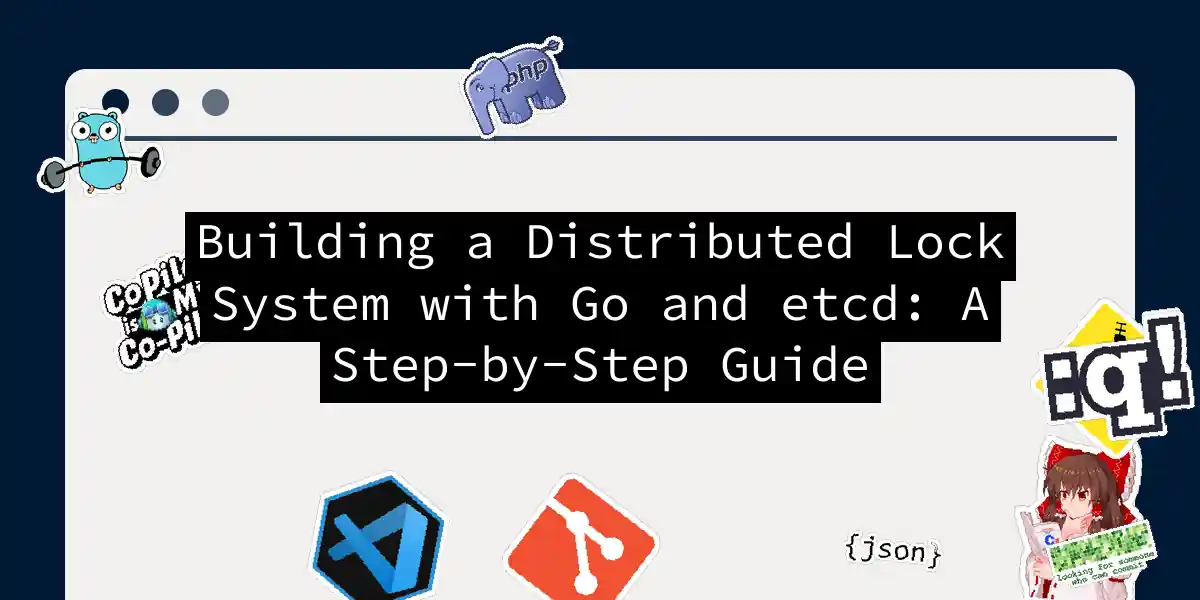Introduction to Distributed Locking
In the world of distributed systems, managing concurrent access to shared resources is a critical challenge. Imagine a scenario where multiple instances of your microservice need to access a shared database or perform some exclusive operation. This is where distributed locking comes into play, ensuring that only one process can access the resource at any given time.
What is etcd?
Before diving into the implementation, let’s understand what etcd is. Etcd is a strongly consistent, distributed key-value store that provides a reliable way to store data in a distributed system. It is widely used in large-scale systems, including Kubernetes, for configuration management and service discovery. Etcd’s ability to maintain consistency across multiple nodes makes it an ideal choice for implementing distributed locking.
Setting Up the Environment
To start building our distributed lock system, you need to have Go installed on your system (version 1.13 or later) and etcd running locally or accessible via a server.
Installing etcd
If you haven’t already installed etcd, you can download it from the official etcd repository and run it locally using the following command:
etcd
Setting Up the Go Project
Create a new Go project and initialize it with the necessary dependencies:
mkdir distributed-lock && cd distributed-lock
go mod init example.com/distributed-lock
go get go.etcd.io/etcd/clientv3
Implementing Distributed Locking
Now, let’s implement the distributed locking mechanism using Go and etcd.
Initializing the etcd Client
First, we need to initialize the etcd client. Here’s how you can do it:
package main
import (
"context"
"fmt"
"log"
"time"
client "go.etcd.io/etcd/client/v3"
"go.etcd.io/etcd/client/v3/concurrency"
)
var lock *concurrency.Mutex
func main() {
// Initialize the etcd client
etcdClient, err := client.New(client.Config{Endpoints: []string{"localhost:2379"}})
if err != nil {
log.Fatal(err)
}
defer etcdClient.Close() // Cleanup
session, err := concurrency.NewSession(etcdClient)
if err != nil {
log.Fatal(err)
}
defer session.Close()
mutex := concurrency.NewMutex(session, "/lock-prefix")
PerformImportantTask(mutex)
}
Lock and Unlock Functions
Here’s a detailed look at the PerformImportantTask function, which demonstrates how to acquire and release a lock:
func PerformImportantTask(mutex *concurrency.Mutex) {
ctx := context.Background()
t := time.Now().Unix()
fmt.Println("Waiting to acquire lock...")
// Only one process can lock, others will wait
mutex.Lock(ctx)
fmt.Printf("Acquired lock after waiting for %d seconds\n", time.Now().Unix()-t)
// Perform the critical section task
fmt.Println("Performing super important task")
time.Sleep(5 * time.Second) // Mock critical section
mutex.Unlock(ctx)
fmt.Println("Done!")
}
How It Works
- Initializing the etcd Client: We connect to the etcd server using the
client.Newfunction. - Creating a Session: We create an election session using
concurrency.NewSession, which generates a lease object in the etcd cluster. - Acquiring the Lock: Calling
mutex.Lock(ctx)creates a key-value pair with the lease, indicating ownership of the lock by an instance. - Releasing the Lock: Calling
mutex.Unlock(ctx)deletes the key-value pair and revokes the lease.
Example Flow
Here is a sequence diagram illustrating the flow of acquiring and releasing a lock:
Advanced Features
Read-Write Locks
For more complex scenarios, you might need read-write locks. The etcd-lock package supports this feature, allowing multiple readers to access the resource simultaneously while ensuring exclusive access for writers[2].
Lock Timeouts and Renewals
To make your lock system more robust, you can implement lock timeouts and renewals. This ensures that a lock is released if the holding process crashes or becomes unresponsive. Here’s an example of how you might implement this using a lease with a specified TTL (Time to Live):
func (dl *DistributedLock) Lock(ctx context.Context, ttl int64) error {
lease, err := dl.etcdClient.Grant(ctx, ttl)
if err != nil {
return err
}
_, err = dl.etcdClient.Put(ctx, dl.Key, dl.Value, clientv3.WithLease(lease.ID))
if err != nil {
return err
}
dl.LeaseID = lease.ID
log.Printf("Lock acquired: %s", dl.Key)
return nil
}
Error Handling and Retries
Proper error handling and retry mechanisms are crucial for a resilient distributed lock system. Here’s an example of how you can handle errors and retries during lock acquisition:
func (dl *DistributedLock) Lock(ctx context.Context, ttl int64) error {
for {
lease, err := dl.etcdClient.Grant(ctx, ttl)
if err != nil {
log.Printf("Error granting lease: %v", err)
time.Sleep(1 * time.Second) // Retry after a short delay
continue
}
_, err = dl.etcdClient.Put(ctx, dl.Key, dl.Value, clientv3.WithLease(lease.ID))
if err != nil {
log.Printf("Error putting key-value pair: %v", err)
time.Sleep(1 * time.Second) // Retry after a short delay
continue
}
dl.LeaseID = lease.ID
log.Printf("Lock acquired: %s", dl.Key)
return nil
}
}
Conclusion
Building a distributed lock system with Go and etcd is a powerful way to manage concurrent access to shared resources in distributed systems. By following the steps outlined above, you can ensure that your system remains consistent and free from race conditions.
Remember, the key to a successful distributed system is not just about the code; it’s about understanding the underlying principles and implementing them with care. So, the next time you’re dealing with multiple instances of your microservice, don’t let them get into a tug-of-war over resources – use etcd to keep the peace.
And as a parting thought, if you ever find yourself in a situation where multiple processes are fighting for a lock, just recall the wise words: “A lock a day keeps the race conditions at bay.” Happy coding
